
© Railway Wonders of the World 2012-


The North British Railway
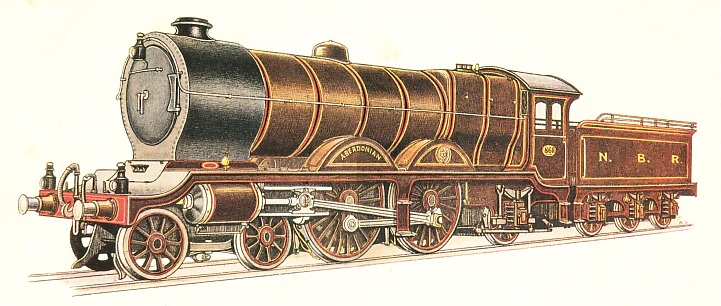
NORTH BRITISH RAILWAY EXPRESS PASSENGER LOCOMOTIVE, No. 868
DESIGNED BY Mr. W. P. REID, M.INST.M.E.
THE North British was the original name of the line which opened in 1846 from Edinburgh to Berwick; but Berwick comes much earlier into railway history, for it was the intended terminus of the Glasgow & Berwick, surveyed by Telford and already referred to, which was projected by Martin Dalrymple of Fordel who died in 1809. Like the others, the North British, which is the longest railway in Scotland by some 350 miles, was built up by amalgamation, and the old companies it absorbed were unusually numerous.
The oldest railway, officially so called, now forming part of its system was the Monkland & Kirkintilloch, which in its Act of 1824 followed the example of the Oystermouth and Stockton & Darlington in obtaining powers to make and erect such and so many locomotive or movable engines as, in short, it pleased, and was likewise permitted to carry passengers. The line, at first single and soon doubled throughout, was opened in 1826, and ran for ten miles northward from the Monkland collieries and ironworks to the Kirkintilloch basin of the Forth & Clyde canal.
By it the coal and iron district of that busy part of Lanarkshire was put into more direct communication with the east coast than by canal. The railway was bitterly, and naturally, opposed by the canal people, but in vain, and with it began that strenuous competition, inadequately described as fights and battles, that has so pleasingly varied the story of railway enterprise north of the Border, the significant signs of which are the spacious legal offices of the two leading companies at Westminster.
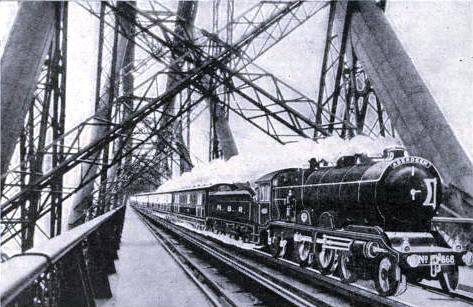
THE FAR NORTH EXPRESS CROSSING THE FORTH BRIDGE
While the Monkland & Kirkintilloch was under construction by Thomas Grainger, who laid out several of the early Scottish lines, it was decided to extend it; and in May 1826, five months before it opened, an Act of Parliament authorised the Ballochney line joining it at Kippbyres and coming in from three branches. The Ballochney was in time extended farther east by the Slamannan, and the three companies amalgamated as the Monkland Railways, which were taken over by the Edinburgh & Glasgow and became part of the North British in 1865.
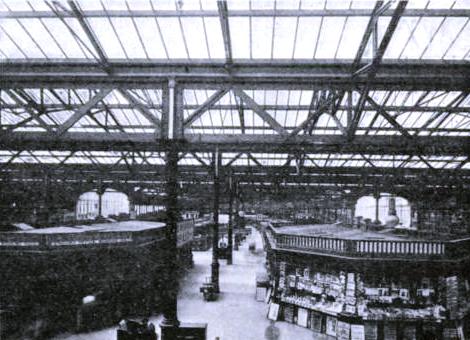
WAVERLEY STATION, EDINBURGH
The Edinburgh & Dalkeith obtained its Act in the same year as the Ballochney, and opened in 1831, the engineer being James Jardine. It ran from St. Leonards to Dalhousie with branches to Dalkeith, South Leith, and Fisherrow. Part of it -
The Fisherrow branch was the Innocent Railway of Robert Chambers. “Nobody,” says he, “is ever too late for the Innocent Railway. One day we had started from Fisherrow up the inclined plane, when a washerwoman, with a huge bundle of clothes upon her back, was seen making after us on the line, occasionally waving a hand in the hope of its prevailing upon the conductor to stop. We thought the poor woman had no sort of chance of making out her passage; but, wonderful to say, she overtook us, burden and all, at a place where a short pause is made a mile and a half forward. There is a second stoppage -

NO. 893 EXPRESS PASSENGER ENGINE “SIR WALTER SCOTT”
The South Leith, the Dalkeith and the Fisherrow branch are still used, having been altered and adapted at an early date, and in 1845 the projected line to Hawick was taken over by the North British, which picked up the Dalkeith on its way to cross the Border, for like the Caledonian it comes south of the Tweed. Nearly a quarter of its Waverley route is in England, and from Riccarton it reaches Morpeth to the east, and Silloth on the Cumberland coast, and Hexham half-
The next old company that should be noticed is the Edinburgh, Leith & Granton, opened in 1842, six years after it was authorised. This was absorbed by the Edinburgh & Northern, and put Edinburgh in communication with Perth and Dundee, or rather Tayport, which meant the same thing, and it was generally known as the Edinburgh & Dundee until it became North British in 1862. If we add to this the Edinburgh & Glasgow, authorised in 1838 and opened in 1842, which the North British acquired in 1865, we shall have said enough for our purpose with regard to these old lines.

THE APPROACH TO WAVERLEY STATION, EDINBURGH
Now the North British extends to Bervie on the east coast and Mallaig on the west, and its farthest north is Fort Augustus, which it reaches through the long West Highland line from Craigendoran opposite Greenock on the Clyde. Its multitudinous loops and branches need not be particularised; suffice it to say that it has about seventy terminal stations and a length of some 1350 miles, of which over 800 are single line. It carries 38 millions of passengers a year, 22 million tons of minerals, and 5 million tons of merchandise; its coaches and wagons exceed 71,000 in number, and it has nearly 900 engines, whose yearly mileage totals up to considerably more than 18 millions. It owns 50 acres of docks, at Silloth, Bo’ness, Alloa, Charlestown, Methil, and Burntisland; and from each of the last two it is shipping 12,000 tons of coal a day. In short, it is the largest Scottish railway though not the most profitable, its capital being £66,000,000, a fifth greater than that of the Caledonian.
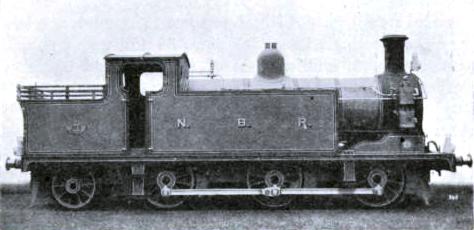
TANK ENGINE NO. 863 -
In Waverley it has the largest station at present in the country. This covers 23 acres, half of which are under glass, and the length of the platforms is close on 2¾ miles -
The road from Berwick is not difficult. From Berwick, along by the cliffs, it rises for five miles past Lamberton, crossing the Border at 1 in 190; then comes a level stretch for four miles, then a rise up the Eye Water at 1 in 200 to Grant’s House, the highest point. For five miles onwards it falls at 1 in 96, continuing by easy undulations until it runs up into Edinburgh at 1 in 78.
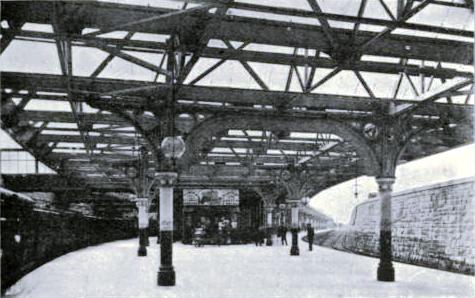
TAY BRIDGE STATION
The Carlisle road is of a more arduous character. Undulating gently for eleven miles it begins to rise for eight, four of which are at 1 in 100, and then it falls for two miles to cross the Border at Kershopefoot. Rising from there it reaches 315 ft a mile beyond Newcastleton, and then up it goes for eight miles at 1 in 75 to the summit, 955 ft, thirty-
The gradients on the Waverley route are not, however, the worst the North British passenger trains meet with. At Causewayend there is one at 1 in 23 for half a mile, and at Commonhead there is another of the same for a quarter of a mile, with one at 1 in 26 and another at 1 in 27. To say nothing of the old approach to Glasgow at 1 in 45, up which the trains were pulled by a rope, there are in Perthshire and out on the West Highland line several sharper than 1 in 75, including at least two of 1 in 53.
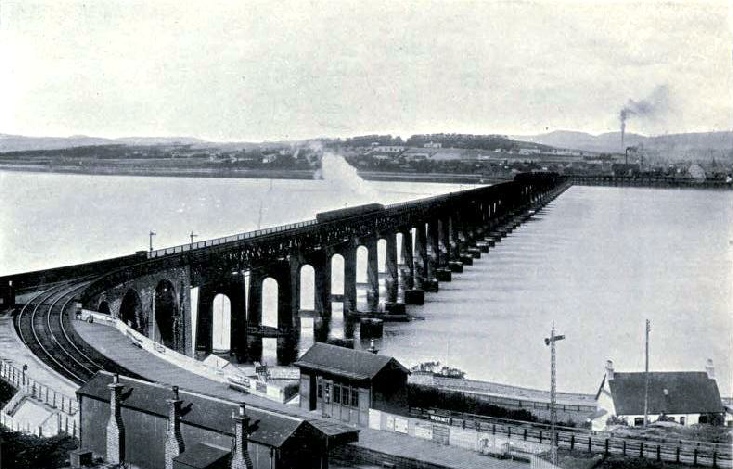
THE NEW TAY BRIDGE
This West Highland line was, to put it mildly, a much discussed railway. That the North British should presume to come running down the north bank of the Clyde to Craigendoran and take a share of the boat traffic was simply horrifying to the Caledonian, but when it came to going north from there up the west coast to Mallaig and to Fort Augustus, as was evidently intended, the Highland joined in the fray, and the heat of opposition to “a project that could never pay” rose to a temperature quite inconceivable by those not engaged in it.
Northward this line goes to Garelochhead, then on, by the side of Loch Long, to Ardlui at the head of Loch Lomond, and up Glen Falloch to Crianlarich on the side of Ben More. Through the deer forests and on across the moor of Rannoch it continues, over the summit level of 1350 ft, to skirt the Treig and, passing the falls of Monessie, reach Spean Bridge in the Ben Nevis country, where it divides; the northern spur going by way of Invergarry to Fort Augustus, while the south-
Before Waverley Station was enlarged it was the standard excuse for the complaint that the North British was most remarkable for its unpunctuality, but there were other reasons for this. The number of connections, mainly forced upon the company by the position of the two estuaries, those of the Forth and Tay, were unusually great. There were connections, for instance, with both the East Coast and Midland routes to England from the west and north of Scotland, those from the latter being most uncertain, especially in stormy weather, while the working of the Forth and Tay ferries at all times constituted the chief difficulty in maintaining punctuality.
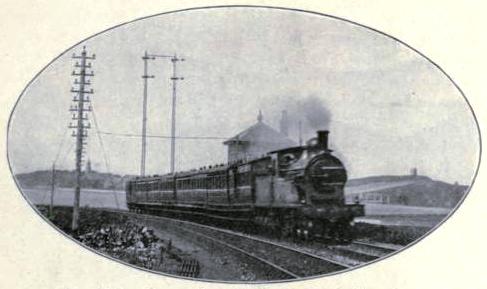
“FLYING SCOTSMAN” PASSING DUNBAR AT 60 MILES AN HOUR
Another improvement, taking the line out of a tangle of many branches and devious loops, was the building of the bridges over the Forth and the Tay, which are the two great engineering works of the system. The first Tay Bridge was swept away with a train on it in a hurricane in December 1879. It was designed by Sir Thomas Bouch, who as a bridge-
His Tay Bridge, within a few yards of two miles in length, consisted of eighty-
While the Tay Bridge stood, Bouch was busy in completing his plans for a colossal suspension bridge over the Forth, with towers 600 ft high on Inchgarvie, which came to nothing, for the disaster simply shattered his reputation, paralysed railway enterprise for a time, and led to the Forth Bridge Company promoting a Bill for the abandonment of their existing works. That there should be a bridge over the estuary, or a tunnel under it, such as that to Rosyth, proposed as far back as 1808, was, however, clearly necessary for the development of the East Coast service, and, after the Bill was deposited, the company was reconstituted at the last moment on three leading engineers reporting that notwithstanding the collapse of the Tay Bridge a suitable, durable structure could be built. And then a design was prepared on quite a different principle.
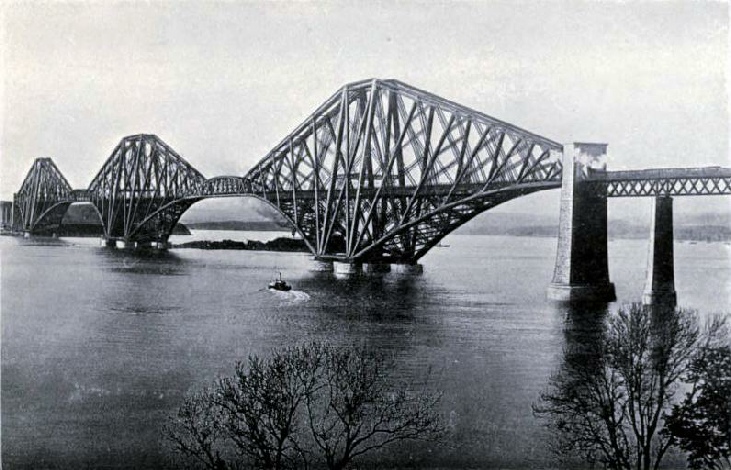
THE FORTH BRIDGE
To carry out this scheme was beyond the means of the North British, though the working of the traffic was to be entrusted to them. So a joint financial arrangement was effected by which the North British guaranteed 30 per cent, of the cost, the Midland 32½ per cent, and the North Eastern and Great Northern jointly 37½ per cent; and thus it came about that in 1882, the year after the Act was obtained for the new Tay Bridge, the Forth Bridge was authorised.
The three engineers on whose report the company was re-
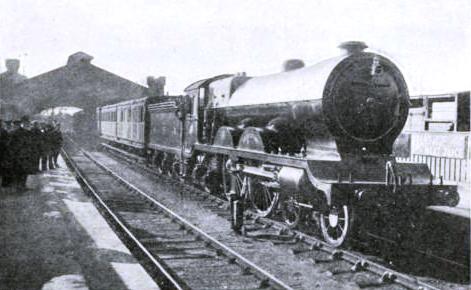
BERWICK STATION
The stupendous structure, so well proportioned that it looks nothing like its size, really supports itself from summit to base at every point it touches the ground, and its dimensions and construction, with the horizontal truncated triangles of its roadway, render it proof against any hurricane that may rage. The principle is that of a pair of brackets placed back to back which balance each other and are anchored at their extremities; and the tubes of these brackets are 12 ft in diameter, the piers that carry them tapering from 70 ft in diameter at the base to 49 ft at the top.
Whenever a train comes on to the bridge there is a pull along the top of the bracket and along all the radii hanging down-
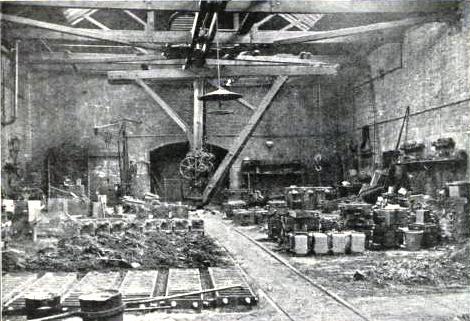
THE MISCELLANEOUS FOUNDRY AT COWLAIRS
The eleven masonry arches account for 521 ft of its length; and then there are eleven girder spans each of 168 ft, two of 173 ft, and two of 179 ft, ending at the masonry piers on each side which rise to 209 ft above high water. Adjoining these are two single cantilever spans each of 689 ft 9-

THE HEAVY FOUNDRY
The tower on Inchgarvie is 260 ft broad, and the towers on either side are 145 ft broad. From the base of the deepest pier to the top of the tower above the height is that of the second pyramid of Egypt. Twice as high as the Newcastle High Level, it would stretch exactly from St. Paul’s Cathedral to the York column in Waterloo Place; and the distance up lower Regent Street to the insurance office ending the vista is the same as the width of one of its spans. Stretching for over a mile and a half across the open water it looks a small thing, there being nothing near by to yield adequate comparison, though the dockyard at Rosyth may furnish something useful in that way.
Unlike other bridges, which arrive more or less ready for erection, it was made on the spot, an extensive establishment being started for the purpose on the south side in 1882 by the builders, Tancred, Arrol, & Co.; and this was for years classed among the interesting industrial works of Edinburgh. The foundations began in January 1883, done by caisson in the usual way but on a giant scale, some of them going down 90 ft below high-
fitted on with elliptical holes providing for expansion and contraction due to change of temperature.
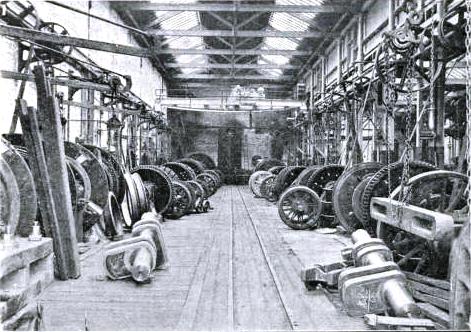
THE WHEEL SHOP, COWLAIRS
The skew-
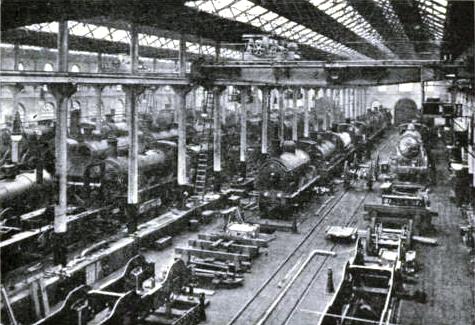
THE ERECTING SHOP
“Not only were the plates pressed,” as was said by the writer at the time, “but they were planed and built up into position and had the rivet holes drilled before they left the shore. The scene at the yard can therefore be imagined. What with planing machines and dressing machines, and the circular saw cutting slabs of solid steel, and the hydraulic rams justifying plates and carving angle-
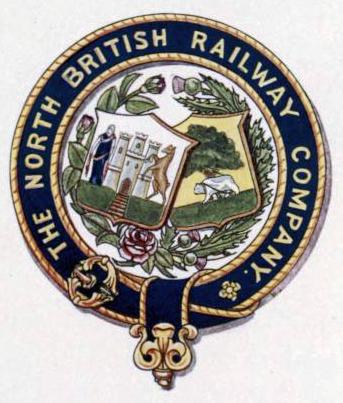 Every appliance known up to then was used in its erection, telegraph, telephone, camera, tramway, wire lift, press, winch, and crane; and as the cantilevers were built out into space, one balancing the other and taking its sole support from it, with the cranes hanging over the outer ends and fishing up the material from the boats 300 ft below, the 3500 men were almost invisible in the steel webs that rose in a line across the Forth. Night and day the work went on, even through midwinter, and in the night the webs stood out in brilliant light and dark shadow in the glare of the hundred arc lamps and hundreds of incandescents that provided an illumination such as had never been seen before.
Every appliance known up to then was used in its erection, telegraph, telephone, camera, tramway, wire lift, press, winch, and crane; and as the cantilevers were built out into space, one balancing the other and taking its sole support from it, with the cranes hanging over the outer ends and fishing up the material from the boats 300 ft below, the 3500 men were almost invisible in the steel webs that rose in a line across the Forth. Night and day the work went on, even through midwinter, and in the night the webs stood out in brilliant light and dark shadow in the glare of the hundred arc lamps and hundreds of incandescents that provided an illumination such as had never been seen before.
Right and left, wider and wider grew the wilderness of work, as the zigzags went on lengthening until they joined up with the zigzags that stretched out northwards and southwards to meet them from the Queensferries. And then there came the painting -
The other great bridge of the line, the second one over the Tay, was designed by Barlow. It was opened in 1887, and is a few yards above the ruins of the first, a large, ordinary-
In the very early days the North British locomotive works were at St. Margaret’s, close to the Edinburgh terminus, where in 1863 there was built the then fastest engine on the line, best known perhaps as No. 1009, practically a Jenny Lind, 2-
When the Edinburgh & Glasgow -
Another well-
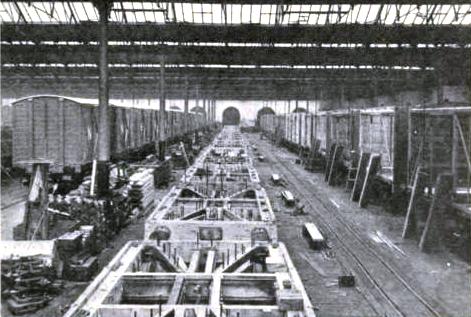
BUILDING COVERED WAGONS AT COWLAIRS
Soon after the Waverley route was opened in May 1876 Mr. Drummond came out with a class of 4-
When the Forth Bridge was opened the engine that drew the first train was No. 602, a 7-
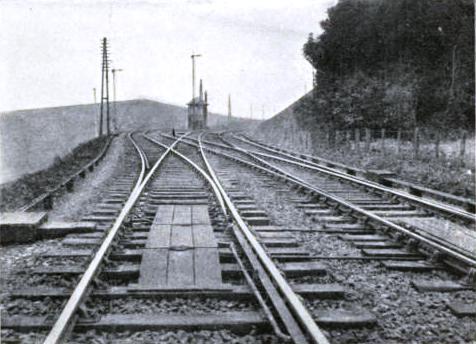
KINNABER. THE JUNCTION OF THE EAST COAST AND WEST COAST ROUTES TO ABERDEEN
To open the West Highland, good hill-
When these tremendous engines are running with the steam shut off and the regulator closed, a jet of steam enters the cylinders and sprays oil into them from an oil cup connected with the automatic relief valve; and there are other ingenuities about them of interest to engineers. They have, of course, the North British bogie without a swinging centre but with inverted laminate springs and floating beams, the trailing boxes having a sliding cover on which the springs bear and underneath which the box is allowed the side play that enables the engine to suit itself to the curve. The cylinders are not horizontal but set at a slope of 1 in 48; the bogie wheels are 3 ft 6-
3-
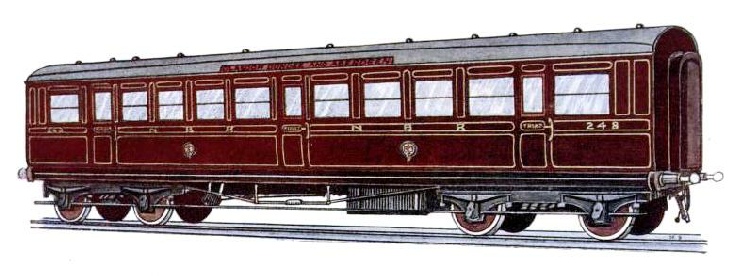
COMPOSITE CORRIDOR CARRIAGE, No. 248
More recent are the Waverley class of 4-
The North British is a complicated system to manage, as can be seen from Bradshaw, where it occupies about 35 pages with no less than 57 different time-
This Dundee & Arbroath line is interesting from its vicissitudes. Its Act was obtained so long ago as 1836, and it opened from Arbroath to Craigie twro years afterwards, reaching Dundee on the 1st of April 1840. It was laid in the old way, much of it on stone blocks -
For some reason it was worked as a right-
An old line was not necessarily a flat line, as witness the just-
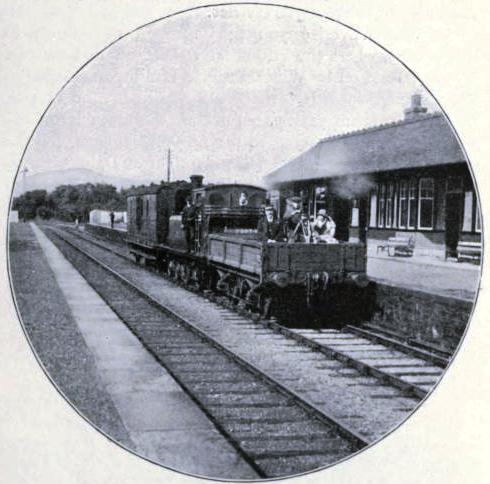
AT ROY BRIDGE. Obtaining moving pictures for the bioscope.
The rope was invaluable to the old engineers for getting up or down to an average level at which the rest of the line could be run. We saw it at Liverpool and at Euston; for many years it was used at Glasgow; but at Edinburgh it was not necessary, as the terminus was in the valley of the North Loch, on the eastern side of Old Waverley Bridge that took the place of the Little Mound. There, between the Edinburgh & Glasgow and Princes Street, but at the end of a rope, was the Edinburgh, Perth, & Dundee, and on the other side was the North British now representing the three. At Cowlairs the rope was used for two years, then for some four years specially designed engines did the work, but these were taken off and the rope reverted to until November 1908. Barring the Cowlairs gradient -
Leaving Waverley you pass through the tunnel to Haymarket, where the Edinburgh & Glasgow ended when it opened, and on by Winchburgh to Linlithgow, thence to Falkirk, and so to Queen Street, where by the City & District you pass under Glasgow to the stations on the north bank of the Clyde as far as Craigendoran. for the coast steamers or the West Highland, or at Dalreoch, just beyond Dumbarton, you run off to Balloch on the shore of Loch Lomond. Thence the steamers take you right up to Ardlui, one of the loveliest, and cheapest, trips discoverable, or land you at Inversnaid, whence the coach will put you on Loch Katrine for the Trossachs, on the circular tour system that Scotland works to perfection and seems to have begun.
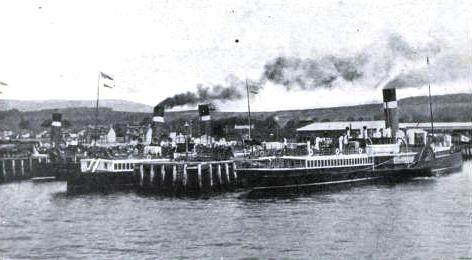
CRAIGENDORAN PIER
You can read more on “The Caledonian Railway”, “The North Eastern Railway” and “The Romance of the LNER” on this website.